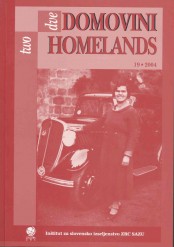The immigrant Is Dead, Long Live The Immigrant: The East European Transmigrant in Contemporary American Literature
Abstract
The post Cold War world order has enabled a new type of literary character to come into existence, one who combines the “cosmopolitan traveler” with the “local native” (James Clifford). The potential for conflict, which was the hallmark of this duality in so-called émigré writing, does not necessarily lead to the “immigrant crisis” anymore. This article deals with three novels written by writers who migrated from former socialist European countries to the USA and decided to deal with the process of migration by implementing this new literary character - the transmigrant. In their novels they introduce a new positive understanding of migration and of the concept of multiple homelands. Aleksandar Hemon’s Nowhere Man, Gary Shteyngart’s The Russian Debutante’s Handbook and Iva Pekarkova’s Gimme the Money express a new positioning of the self in the world and thus redefine the concept of cosmopolitanism, traditionally associated with expatriate writing.
The term transmigrant has its origins in sociology. Social scientists like Nina Glick-Schiller, Linda Basch, Christina Blanc-Szanton, Ludger Pries and Ulrich Beck promote the awareness of a new type of migrant to go along with the traditional categories of the immigrant, the emigrant and the migrant in the field of migration studies – the transmigrant. She/he differs from former types of migrants by productively combining and making use of multiple countries – the country (or countries) of consent and the country of descent (Werner Sollors). By actively taking part in the social, cultural and political life of both countries they shed a positive light on the question of migration. The same kind of changes can be noted in contemporary literature. This article deals with the figure of the transmigrant dwelling within the former socialist countries in Eastern Europe and the USA. Major differences in the construction of a protagonist in contemporary migrant postsocialist literature compared to that of former immigrant and émigré literature (in particular that written during the Great Migration and the Cold War period) that led to the introduction of the transmigrant are:
1. connecting the ‘former identity’ with the ‘new identity’;
2. individualizing the immigrant subject;
3. introducing an ongoing sense of arrival which replaces the traditional concept of an initial and all encompassing arrival;
4. allowing fragmentary and illogical speech as a product of bilinguality;
5. acknowledgement of contradiction in various fields of immigrant life
These writers create an apparatus for future writers to use, since our “age of migration” (Stephen Castles/Mark Miller) will certainly bring more cross-cultural movements and inter-ethnic locations. The implementation of the term transmigrant in literary studies enables critics and academics to react to the changing migration landscape and to articulate this new awareness in their studies.
Downloads
References
Amireh, Amal / Lisa Suhair Majaj, ed. 2000. Going Global: The Transnational Receplion of Third World Women Wrilers. New York, London: Garland Pub lishing, Inc.
Appadurai, Arjun. 2000. „The grounds of the nation-state: identity, violence and territory.“ ln: Kjell Goldmann, Ulf Hannerz, Charles Westin. Nalionalism and Internationalism in the Post-Cold War Era, London, New York: Routledge, pp. 129-143.
Appiah, KwameAnthony. 1997. ,,Cosmopolitan Patriots“. Critical Inquiry, 23 (Spring 1997).
Boume, Randolph. 1977. ,,Trans-National America.“ In: The Radical Will: Selected Writings 1911-1918. Randolph Boume. New York: Urizen Books, pp. 249-264.
Brennan, Timothy. 1997. At Home in the World: Cosmopolitanism Now. Cam bridge/London: Harvard UP.
Glick Schiller, Nina; Basch, Linda; Blanc-Szanton, Cristina, hg. 2002. Towards a Transnational Perspective on Migration: Race, Class, Ethnicity, and Natio nalism Reconsidered. New York: The New Academy of Science.
Hall, Stuart. 1990. “Cultural Identity and Diaspora.” In: Identity: Community, Culture, Difference. Hg. Jonathan Rutherford. London: Lawrence & Wishart, pp. 222-237.
Hemon, Aleksandar. 2002. Nowhere Man. New York: Doubleday/Nan A. Talese.
Morrison, Toni. 1993. Playing in the Dark: Whiteness and theLiterary Imagination. New York: Vintage.
Pekarkova, Iva. 2000. Gimme the Money. London: Serpent’s Tail.
Shteyngart, Gary. 2002. The Russian Debutante's Handbook. New York: River- head.
Sollors, Werner. 1986. BeyondEthnicity: Concent andDescent in American Culture. New York, Oxford: Oxford UP.
Downloads
Published
How to Cite
Issue
Section
License

This work is licensed under a Creative Commons Attribution-NonCommercial-NoDerivatives 4.0 International License.
Authors guarantee that the work is their own original creation and does not infringe any statutory or common-law copyright or any proprietary right of any third party. In case of claims by third parties, authors commit their self to defend the interests of the publisher, and shall cover any potential costs.
More in: Submission chapter





